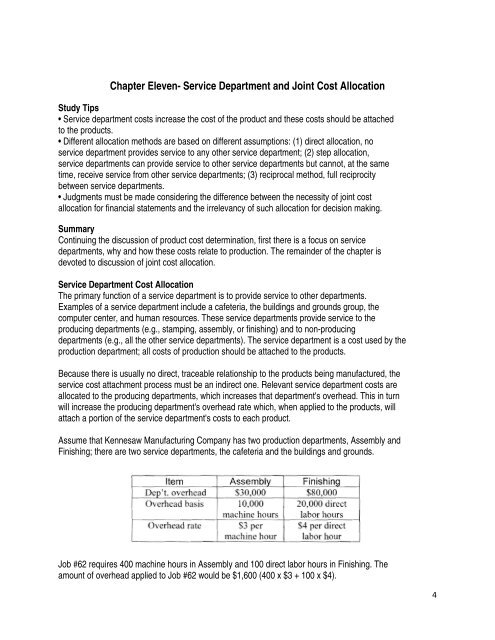Chapter Nine- Activity-Based Costing
Chapter Nine- Activity-Based Costing
Chapter Nine- Activity-Based Costing
Create successful ePaper yourself
Turn your PDF publications into a flip-book with our unique Google optimized e-Paper software.
<strong>Chapter</strong> Eleven- Service Department and Joint Cost Allocation<br />
Study Tips<br />
• Service department costs increase the cost of the product and these costs should be attached<br />
to the products.<br />
• Different allocation methods are based on different assumptions: (1) direct allocation, no<br />
service department provides service to any other service department; (2) step allocation,<br />
service departments can provide service to other service departments but cannot, at the same<br />
time, receive service from other service departments; (3) reciprocal method, full reciprocity<br />
between service departments.<br />
• Judgments must be made considering the difference between the necessity of joint cost<br />
allocation for financial statements and the irrelevancy of such allocation for decision making.<br />
Summary<br />
Continuing the discussion of product cost determination, first there is a focus on service<br />
departments, why and how these costs relate to production. The remainder of the chapter is<br />
devoted to discussion of joint cost allocation.<br />
Service Department Cost Allocation<br />
The primary function of a service department is to provide service to other departments.<br />
Examples of a service department include a cafeteria, the buildings and grounds group, the<br />
computer center, and human resources. These service departments provide service to the<br />
producing departments (e.g., stamping, assembly, or finishing) and to non-producing<br />
departments (e.g., all the other service departments). The service department is a cost used by the<br />
production department; all costs of production should be attached to the products.<br />
Because there is usually no direct, traceable relationship to the products being manufactured, the<br />
service cost attachment process must be an indirect one. Relevant service department costs are<br />
allocated to the producing departments, which increases that department's overhead. This in turn<br />
will increase the producing department's overhead rate which, when applied to the products, will<br />
attach a portion of the service department's costs to each product.<br />
Assume that Kennesaw Manufacturing Company has two production departments, Assembly and<br />
Finishing; there are two service departments, the cafeteria and the buildings and grounds.<br />
Job #62 requires 400 machine hours in Assembly and 100 direct labor hours in Finishing. The<br />
amount of overhead applied to Job #62 would be $1,600 (400 x $3 + 100 x $4).<br />
4
















